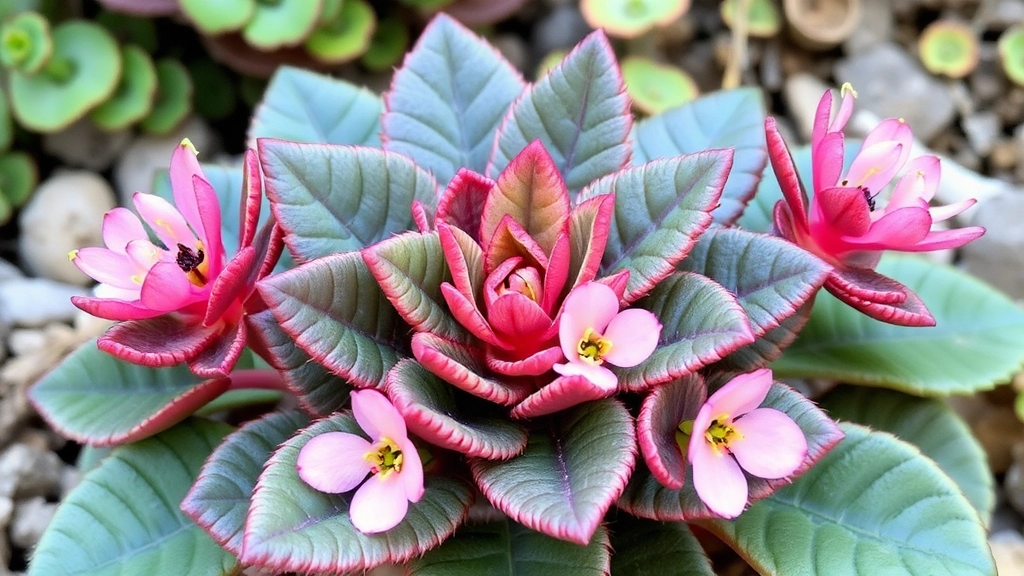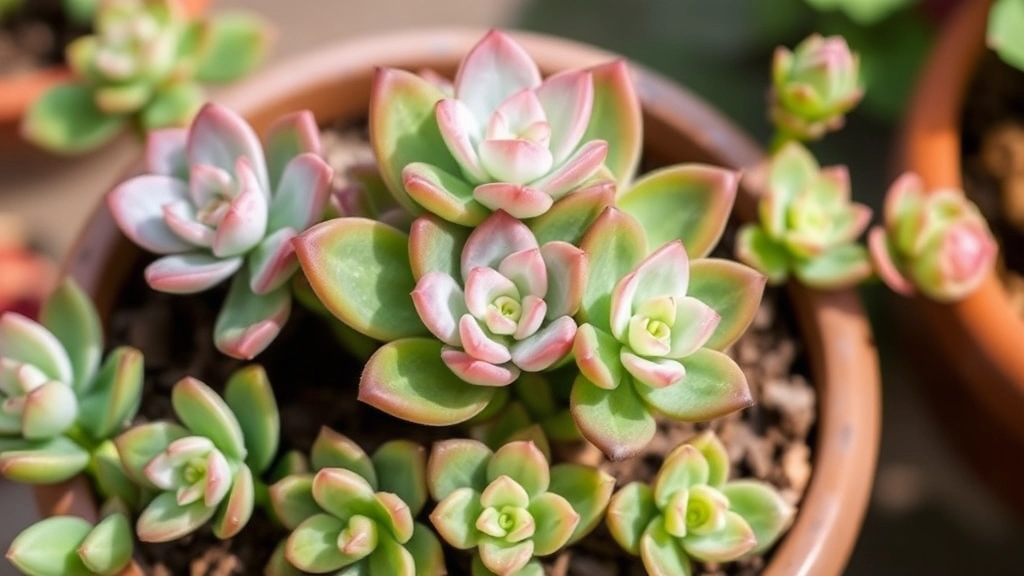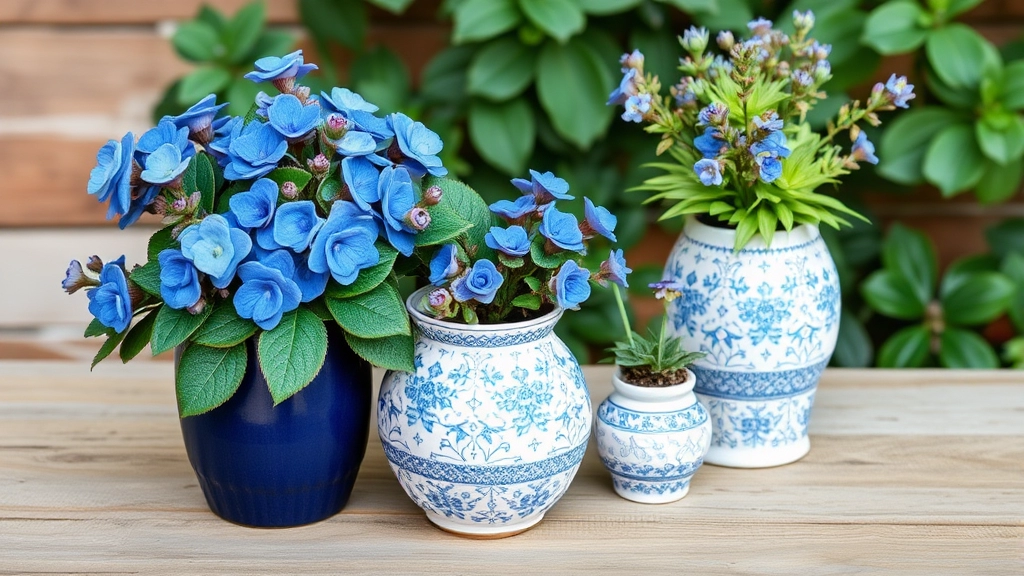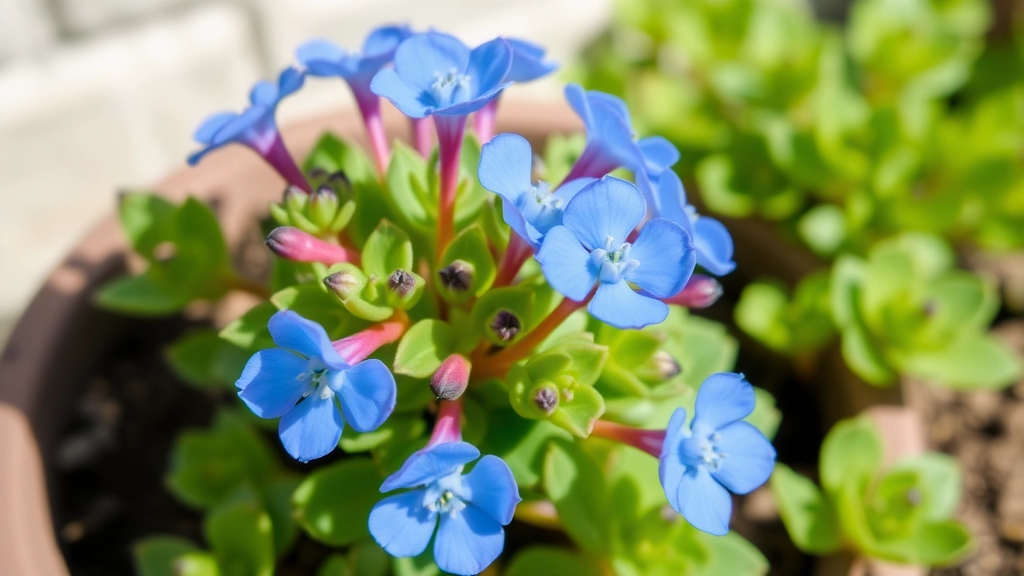Discover the Blue Kalanchoe Plant
Are you curious about the Blue Kalanchoe Plant? This unique succulent, known scientifically as Kalanchoe eriophylla, boasts stunning blue-toned, fuzzy leaves that make it a standout addition to any plant collection. Whether you’re a seasoned gardener or a newbie plant enthusiast, this guide will provide you with all the essential care tips, propagation techniques, and decorating ideas to help you make the most of your Blue Kalanchoe.
The Blue Kalanchoe Plant is not just eye-catching but also incredibly easy to maintain. It thrives in low-water, drought-tolerant conditions, making it perfect for those who might not have a green thumb. In this article, we’ll explore everything from its unique characteristics to ideal growing conditions, and even where you can purchase this beautiful plant. Stay tuned to transform your space with the charm of the Blue Kalanchoe!
Have you ever come across a plant that captures your attention with its striking hues and unique charm?
The Blue Kalanchoe, specifically *Kalanchoe eriophylla*, is a succulent that stands out for its captivating blue-grey foliage and vibrant flowers.
This delightful plant is part of the Crassulaceae family and is known for its resilience and low maintenance needs, making it a favourite among both novice and seasoned gardeners.
## Key Features of Blue Kalanchoe:
– **Foliage**: The leaves are fleshy, with a distinctive blue-grey colour that can add a unique touch to your indoor or outdoor space.
– **Flowers**: When in bloom, the Blue Kalanchoe produces clusters of small, tubular flowers that can range from pink to purple, creating a stunning contrast against its leaves.
– **Size**: Typically, this plant grows to about 30 cm in height, making it ideal for pots or small garden spaces.
This succulent is not just a pretty face; it’s also highly adaptable, thriving in various conditions. For more tips on how to ensure your Kalanchoe blooms beautifully, check out our [guide to caring for Kalanchoe house plants](https://planthq.org/guide-to-caring-for-kalanchoe-house-plants-in-the-uk/). If you’re curious about other unique Kalanchoe varieties, explore our [comprehensive Kalanchoe species list](https://planthq.org/comprehensive-kalanchoe-species-list-for-gardeners/).
Unique Characteristics of Kalanchoe eriophylla

Now that we’ve set the stage for the Blue Kalanchoe, let’s dive into what makes Kalanchoe eriophylla truly stand out.
Are you curious about what makes this succulent so special? Well, let’s explore its unique traits!
Distinctive Features
- Fuzzy Leaves: One of the first things you’ll notice is the soft, fuzzy leaves. They’re not just for show; this texture helps reduce water loss, which is vital for a succulent.
- Vibrant Blue-Green Hue: The leaves sport a stunning blue-green shade that can brighten up any space. This unique colour is a real conversation starter!
- Compact Growth Habit: Kalanchoe eriophylla tends to stay relatively small, making it perfect for windowsills or small spaces. It’s a low-maintenance companion that won’t take over your living area.
- Flower Power: When it flowers, it produces lovely clusters of small, tubular blooms. These flowers can vary in colour, but they often complement the plant’s foliage beautifully.
- Easy to Care For: This plant is not just pretty; it’s also forgiving. If you forget to water it occasionally, it won’t hold a grudge.
Fun Fact
Did you know that Kalanchoe eriophylla is often referred to as the “Mother of Thousands”? This nickname comes from its ability to produce tiny plantlets along the edges of its leaves. Talk about a plant that knows how to multiply!
Ideal Growing Conditions for Blue Kalanchoe
Understanding the ideal growing conditions for Blue Kalanchoe is essential for nurturing a healthy plant. Many enthusiasts often wonder what their beloved succulents truly need to thrive.
Light Requirements
Blue Kalanchoe thrives in bright, indirect sunlight.
- Optimal Positioning: Place your plant near a window where it can soak up the light without being scorched.
- Avoid Direct Sunlight: Too much direct sun can lead to leaf burn, causing unsightly brown patches.
Temperature and Humidity
This succulent prefers a warm, dry environment.
- Ideal Temperature: Aim for temperatures between 18°C to 24°C (65°F to 75°F).
- Humidity Levels: Low humidity is best; avoid overly moist areas to prevent rot.
Soil Composition
Choosing the right soil is crucial for Blue Kalanchoe’s health.
- Well-Draining Soil: Use a cactus or succulent mix that allows water to flow freely.
- pH Level: A slightly acidic to neutral pH (around 6.0 to 7.0) is ideal.
Watering Practices
Watering can be a significant concern for many plant owners.
- Frequency: Water when the top inch of soil feels dry.
- Technique: Ensure excess water drains out to avoid root rot.
Fertilisation
Providing nutrients can enhance growth.
How to Propagate Blue Kalanchoe Succulents

Many plant enthusiasts often wonder how to propagate Blue Kalanchoe succulents effectively.
Understanding Propagation
Propagation is the process of creating new plants from existing ones.
For Blue Kalanchoe, this can be done through leaf cuttings or offsets.
Steps for Leaf Cutting Propagation
- Choose a Healthy Leaf: Select a mature leaf from the parent plant.
- Cut the Leaf: Use a clean, sharp knife to cut the leaf at its base.
- Allow to Callous: Place the leaf in a dry, shaded area for a few days until the cut end forms a callous.
- Prepare the Soil: Use a well-draining succulent mix.
- Plant the Leaf: Insert the calloused end into the soil, ensuring it’s stable.
- Water Sparingly: Mist the soil lightly, avoiding overwatering.
Steps for Offsets Propagation
- Identify Offsets: Look for small plantlets growing around the base of the parent plant.
- Gently Remove: Carefully detach the offset from the parent using your fingers or a knife.
- Allow to Callous: Let the offset sit for a day or two to form a callous on the cut end.
- Plant in Soil: Place it in a well-draining succulent mix.
- Water Lightly: Water sparingly until roots develop.
Tips for Successful Propagation
- Temperature: Keep the cuttings in a warm environment (around 20-25°C).
- Light: Provide indirect sunlight to encourage growth.
- Patience: It may take a few weeks for roots to develop.
Common Issues and Solutions for Blue Kalanchoe Care
Caring for Blue Kalanchoe can sometimes feel like navigating a maze, especially when unexpected issues arise.
Common Problems and Their Solutions
-
Overwatering
- Symptoms: Yellowing leaves, mushy stems.
- Solution: Allow the soil to dry out completely between waterings. Use well-draining soil and pots with drainage holes.
-
Underwatering
- Symptoms: Wrinkled leaves, drooping appearance.
- Solution: Water thoroughly when the top inch of soil feels dry. Ensure consistent watering during the growing season.
-
Pest Infestations
- Common Pests: Mealybugs and aphids.
- Symptoms: Sticky residue, visible bugs on the plant.
- Solution: Remove pests by hand or use insecticidal soap. Regularly inspect your plant for early signs of infestation.
-
Insufficient Light
- Symptoms: Leggy growth, pale leaves.
- Solution: Place your Blue Kalanchoe in bright, indirect sunlight. A south-facing window is ideal.
-
Temperature Fluctuations
- Symptoms: Leaf drop or browning edges.
- Solution: Maintain a stable environment. Ideal temperatures range between 18°C to 24°C (65°F to 75°F).
-
Nutrient Deficiency
- Symptoms: Stunted growth, discoloured leaves.
- Solution: Feed with a balanced, diluted succulent fertiliser during the growing season. Avoid over-fertilising.
By addressing these common issues with straightforward solutions, you can ensure your Blue Kalanchoe thrives beautifully. For more detailed advice, you might find our Complete Guide to Kalanchoe Plant Care very helpful. Additionally, if you’re dealing with leaf discoloration, our article on Why Are My Kalanchoe Leaves Turning Red? offers detailed insights and solutions.
Decorating Ideas with Blue Kalanchoe

So, you’ve got your Blue Kalanchoe and you’re wondering how to make it shine in your space?
Let’s dive into some creative ways to incorporate this stunning succulent into your home decor.
1. Table Centerpieces
- Place your Blue Kalanchoe in a stylish pot and set it on your dining or coffee table.
- Pair it with contrasting decor items, like a rustic wooden tray or a sleek glass vase, to make it pop.
2. Window Sills
- These plants thrive in bright light, so why not showcase them on your window sill?
- Use a mix of heights by grouping different pots together—think of varying sizes and shapes for a dynamic look.
3. Hanging Planters
- If you’re short on space, hanging planters are a great option.
- Choose a macramé hanger or a modern metal one to add some flair while saving surface space.
4. Bookshelves and Shelving Units
- Position your Blue Kalanchoe on a bookshelf with books or other decor items.
- It adds a splash of colour and life, breaking up the monotony of books.
5. Bathroom Decor
- Believe it or not, Kalanchoe can thrive in humid environments.
- Place a pot on your bathroom shelf or sink for a fresh, vibrant touch.
6. Outdoor Spaces
- If you have a patio or balcony, consider placing your Blue Kalanchoe in a decorative pot outside.
- It can add a lovely touch to your outdoor seating area, especially during warmer months.
7. Gift Ideas
- Blue Kalanchoe makes a thoughtful gift for friends and family.
- Wrap it up nicely with a personal note, and you’ve got a unique present that keeps on giving.
Where to Buy Blue Kalanchoe Plants
When considering adding a Blue Kalanchoe to your collection, finding the right source is crucial. You might be wondering where to locate these stunning plants.
Local Nurseries and Garden Centres
One of the best places to start is your local nurseries and garden centres.
- Benefits:
- You can inspect the plant’s health before purchasing.
- Local experts can provide tailored care advice.
Online Retailers
If you prefer the convenience of shopping from home, several online retailers offer Blue Kalanchoe plants.
- Popular Options:
- Etsy: A platform for unique and often handmade plants.
- Amazon: A wide variety of sellers and competitive pricing.
- Specialty Succulent Stores: Websites dedicated to succulents often have a broader selection.
Plant Expos and Farmers’ Markets
Attending plant expos or your local farmers’ market can also yield great finds.
- Advantages:
- You may discover rare varieties.
- You support local growers and artisans.
Social Media and Plant Groups
Don’t overlook social media platforms!
- Facebook Groups and Instagram: Many plant enthusiasts sell or trade their plants.
- Local Plant Swaps: A great way to get a Blue Kalanchoe while connecting with fellow plant lovers.
For more detailed care information, you might find our Ultimate Guide to Kalanchoe Blossfeldiana Hybrid Care helpful. If you’re curious about the health benefits of Kalanchoe plants, check out our article on the Health Benefits of Kalanchoe Pinnata.
FAQs about Blue Kalanchoe Plant
What makes Kalanchoe eriophylla unique?
Kalanchoe eriophylla, also known as the Blue Kalanchoe, is distinguished by its fuzzy leaves, vibrant blue-green hue, compact growth habit, and lovely clusters of tubular blooms. It is also known for being easy to care for, making it a great choice for beginners.
Why are the leaves of Blue Kalanchoe fuzzy?
The soft, fuzzy texture of the leaves helps reduce water loss, which is essential for a succulent’s survival in dry conditions.
How can I propagate Blue Kalanchoe succulents?
You can propagate Blue Kalanchoe through leaf cuttings or offsets. Both methods involve cutting a part of the plant, allowing it to callous, and then planting it in well-draining soil.
What are the steps for leaf cutting propagation?
To propagate using leaf cuttings:
- Choose a healthy leaf from the parent plant.
- Cut the leaf at its base with a clean, sharp knife.
- Allow the cut end to callous in a dry, shaded area for a few days.
- Prepare well-draining succulent soil.
- Insert the calloused end into the soil.
- Water sparingly by misting the soil lightly.
What are the steps for offsets propagation?
To propagate using offsets:
- Identify small plantlets growing around the base of the parent plant.
- Gently remove the offset using your fingers or a knife.
- Allow the offset to callous for a day or two.
- Plant it in well-draining succulent soil.
- Water lightly until roots develop.
What are some decorating ideas with Blue Kalanchoe?
You can incorporate Blue Kalanchoe into your home decor in various ways, such as:
- Using it as a table centerpiece.
- Placing it on window sills.
- Hanging it in planters to save space.
- Positioning it on bookshelves or shelving units.
- Adding it to bathroom decor.
- Placing it in outdoor spaces like patios or balconies.
- Giving it as a thoughtful gift.
What is a fun fact about Kalanchoe eriophylla?
Kalanchoe eriophylla is often referred to as the “Mother of Thousands” because it can produce tiny plantlets along the edges of its leaves, making it a prolific multiplier.
What are the ideal conditions for propagating Blue Kalanchoe?
For successful propagation, keep the cuttings in a warm environment (around 20-25°C), provide indirect sunlight, and be patient as it may take a few weeks for roots to develop.
References
-
Kalanchoe eriophylla ‘Pink Butterflies’
-
Kalanchoe – Succulent Plant
-
Gardening 101: Kalanchoe
